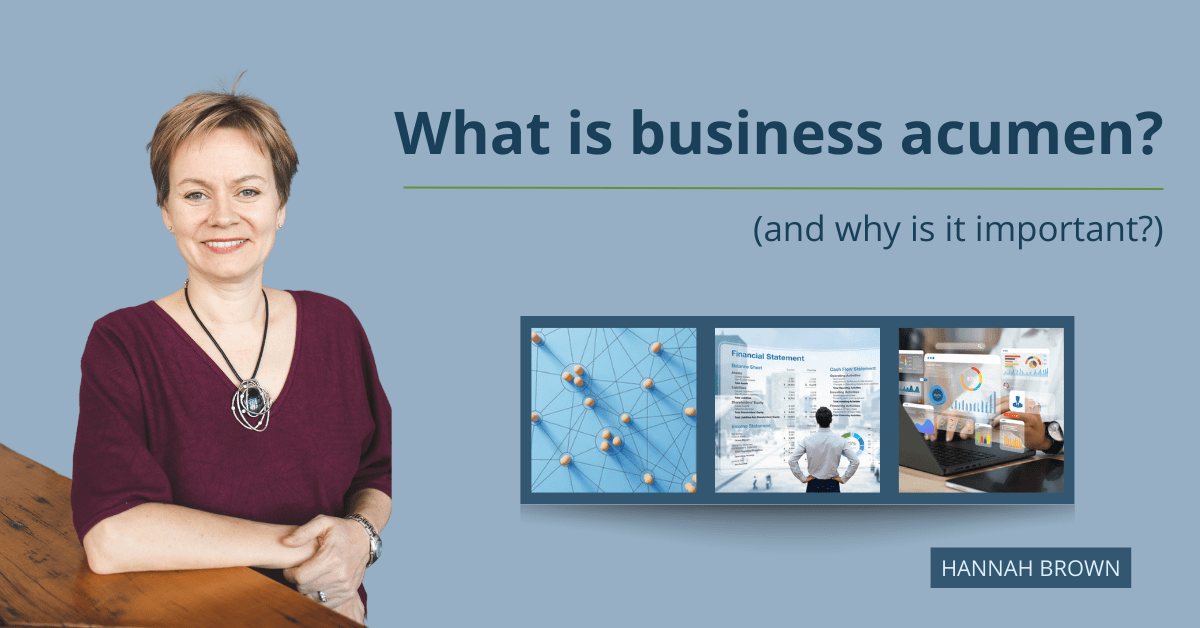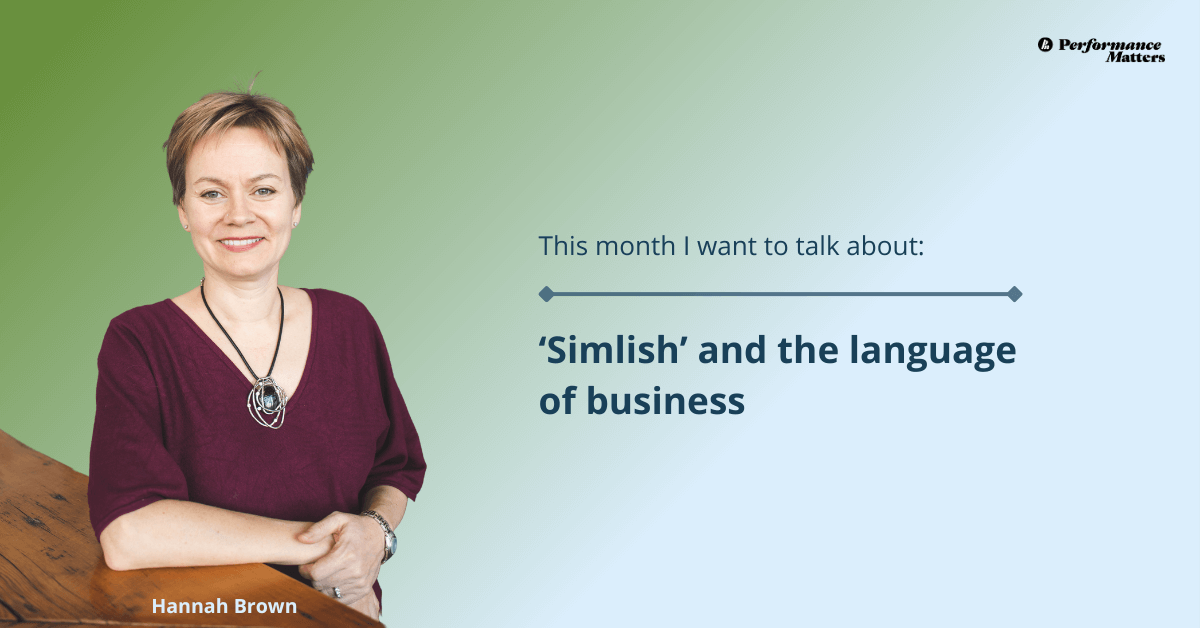I worked at a life insurance company in my mid 30’s. In my first few weeks, Mark, who headed up product development, told me that he thought my boss Neil had made a poor decision in hiring me. Before joining the company, I worked as a consultant, and Neil was my client. So, we knew each other, and I’m pretty sure Neil felt confident in his decision. What Mark was suggesting (rather rudely) was that while I had loads of experience in learning and development, I knew very little about life insurance. He had a point, and I took it to heart. I turned around and completed the courses to obtain my life insurance license – not ever to sell life insurance, but so that I understood the products the company sold and could gain the business acumen skills Mark pointed out that I lacked.
Business acumen is one of those terms people often use. It’s also one of those terms that isn’t commonly defined, so people have a different understanding of what it means. I’d like to offer a definition and share the business acumen skills I think learning professionals need to support them in their role as business partners.
Business Acumen
I like Steven Haines’ definition of business acumen. “Business acumen is a portfolio of skills, behaviors, and capabilities needed to support an organization in the achievement of its financial and strategic goals” 1 In his book, Steven Haines takes a broad view of business acumen that includes personal characteristics, interpersonal skills and business knowledge. I’m going to focus on business knowledge.
Learning and development as a function
The first aspect of business acumen is knowing who you are in relation to others. It includes viewing learning and development as a function much like finance, operations, marketing, etc. Importantly, it also includes taking a systems view and understanding the other functions and their interrelatedness.
Think of your organization and the connected functional areas as a spider web. Did you know there are six different types of spider webs? Just like there are different types of webs, there are different organizational structures. This is important to know because the structure forms the foundation for how functional areas interact.
- Is your organization structured functionally – marketing department, sales, operations etc. all reporting to a CEO?
- Is your organization structured around products with product lines reporting into a group leader or general manager and corporate functions like finance and IT reporting to the CEO?
- If your organization is international, it may be structured around geographical areas with functional areas in each region.
Once you know how your organization is structured, consider how the areas are interrelated. Ultimately you need to know how learning and development fits into the structure so you can support your clients and understand the environment in which they operate.
Financial literacy
Another area of business acumen is financial literacy. Finance is how money moves in, through and out of an organization. Accounting is focused on keeping records and summarizing financial transactions. While you don’t need to be an expert in either, you do need a foundational understanding of both.
Finance
Finance is more strategic and forward looking. It’s focused on the management and allocation of resources. The primary objective is to use financial resources effectively and increase the value and profitability of the organization.
For example, if you want to invest in a Learning Management System (LMS) you will need to create a business case, including the capital required, a risk assessment, and the expected return on the investment. This is a forward-looking, strategic investment the organization would make in learning and development.
Accounting
Accounting is the systematic and comprehensive recording, categorizing, and summarizing of financial transactions. It meticulously tracks all financial activities, providing an accurate financial picture of an organization at any given time. The objective is to accurately document financial activities which generates standard statements (i.e., balance sheet, income statement and cash flow statement). These statements provide the information needed for financial strategic decision-making.
Using the example above, if your department obtains an LMS, you would track the initial and ongoing costs. If you hire an LMS administrator, this would be an expense you record on your budget. Your budget is essentially an income statement for your department.
To summarize, finance is about managing the company’s money, and accounting is about keeping an accurate record of these money matters.
Data analytics for decision making
Finally, business acumen includes capturing data, analyzing it to identify the story it tells, and using that insight to make decisions.
Often learning and development professionals rely on data collected in their functional area – the number of participants who completed a course, program feedback on the design and facilitation. Depending on the program and your team’s capabilities, you may also do pre- and post-tests or use observations to assess learning and on-the-job performance changes. The challenge is that by focusing on learning and development data, learning professionals are only gathering part of the data.
It’s like the parable of the six blind men feeling an elephant. The first touches the side and thinks the elephant is like a wall. The second feels the tusk and declares the elephant is like a sword. The parable continues with each person having a very different impression of the elephant.
Often learning professionals are like the blind men, understanding employees from only their perspective. Learning professionals need to take the blinders off to see the entire elephant. They need to see beyond learners and participants to see employees. They need to capture data outside of learning and development and include data from other functional areas to create a full understanding of employees.
Once data is captured, learning professionals need to analyze the data. Like a detective sifting through clues, you need to uncover the story the data tells. Dust off your Intro to Statistics lessons and use AI tools to identify patterns, trends, and correlations. The data might reveal that employees who complete a certain program are more likely to have lateral transfers or employees who work with a coach or mentor reach a higher level of seniority than those who do not.
Ultimately the purpose of collecting and analyzing data is to inform business decisions. With the examples above, the data and the story it tells would determine how much time and money to invest in a coaching or mentoring program.
Business acumen starts to feel a bit circular at this point. Knowledge of the organization’s functional areas helps to identify sources of data. Financial acumen opens up a world of data about the financial health of the organization and the learning and development department. Data analytics helps decipher this data, identify the story and help to make informed business decisions.
When learning and development professionals gain business acumen skills, you broaden your world from a learning and development silo to the broader world of business. Whether you are like me and have a jarring experience where your shortcomings are pointed out, or if you find you’re in meetings and not following along, gaining business acumen skills is an essential step along your career path. You move from being viewed as an order taker or an expert with a narrow domain of expertise so someone whose opinion is sought and who can provide a valuable perspective not just on learning and development but performance and business decisions.
1 The Business Acumen Handbook: Everything you need to know to succeed in the corporate world” Steven Haines, 2022.
In case you missed it
I’ve shared some additional posts online. I’ve been exploring training from an organization’s perspective and learning from an employee’s perspective. Here they are in case you missed them.
- Learning and project management for a positive reputation – (video link)
- Project management and business acumen leads to sooth training implementation – (video link)
- Performance Consultant – the intersection of Learning acumen and Business acumen– (video link)
- Manager’s role in learning – Analysis phase – (video link)



